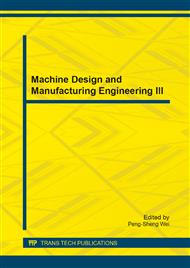p.166
p.171
p.176
p.181
p.185
p.193
p.197
p.205
p.209
Experimental Study of Injection Conditions for a Thin-Walled Wax Pattern Using Response Surface Methodology
Abstract:
In this paper, the relationship between the shrinkage of the thin-walled wax part in the investment casting process (ICP) and the process parameters including mold temperature, melt temperature, packing pressure and holding time are investigated through a series of experiments. The relationship is successfully described by a mathematical regression model which is based on the response surface methodology (RSM). The rationality and adequacy of the mathematical model are checked via analysis of variation (ANOVA) and a sensitivity analysis for process parameters on the dimensional shrinkage variation are conducted which shows that the contribution percentages of mold temperature, melt temperature, packing pressure and holding time are 23.77%, 43.67%, 11.85% and 16.99%, respectively. Additionally, the optimal setting of the process parameters is also obtained by calculating the desirability function. The optimal combination of the mold temperature, melt temperature, packing pressure, and holding time is 74°C, 30°C 25bar, and 5 sec, respectively.
Info:
Periodical:
Pages:
185-192
Citation:
Online since:
July 2014
Authors:
Keywords:
Price:
Сopyright:
© 2014 Trans Tech Publications Ltd. All Rights Reserved
Share:
Citation:


